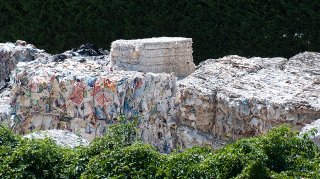Jun 8 2015
In collaboration with the University of Twente (UT), the company Alucha will be constructing a mobile, self-regulating pyrolysis plant for re-use of paper sludge in the summer of 2015.
Paper sludge is responsible for the largest portion of waste generated by paper factories. UT will be helping the industry by giving them a way to convert waste paper sludge into reusable raw materials and bio-oils.

Heating organic material for only a few seconds in the absence of oxygen until it "cracks", is the fundamental way in which pyrolysis works. UT specializes in biomass pyrolysis, including materials such as algae, straw, grass and wood. Following pyrolysis, various types of products and fuels can be obtained from these materials. UT has built an advanced reactor which is being tested at its Thermal Engineering lab.
Out-of-the-box Thinking
“Paper sludge is half organic paper fibres and half minerals" says Gerrit Brem, professor in Energy Technology at the University of Twente. "When Alucha approached us with this question about paper sludge, we started experimenting out-of-the-box with our existing pyrolysis technology. We designed a new pyrolysis system that's particularly suitable for paper sludge and similar waste streams. We have now applied for a patent for this new reactor. The reactor can process both small and large particles and requires no external energy. After drying and pyrolysis, the fibres in the paper sludge are transformed into oil and flammable gas and the minerals can be used as a raw material for the paper industry. Moreover, you keep the paper industry from having to dump this waste stream for 70 euro per ton, as is now the case. So we can transform this entire waste stream into something useful and that's a huge step forward.”
Contributing to Production
The new mobile unit makes a significant contribution to the production chain, as it does not require any large scale installations or transport. Additionally, the pyrolysis oil derived from this process, as well as the minerals obtained, could be used by the industry for their production processes.
A pyrolysis plant is to be installed in Arnhem at the Kleefse Waard industrial estate. Alucha expects this plant to commence operations by mid-2016. Following this, Alucha plans to execute more pyrolysis installations. More paper factories are expected to install these units. SCA, a Swedish paper company, is to be the first customer for the mobile unit.
“In 2010, we started testing at laboratory scale using a single kilogram of paper pulp", said Gijs Jansen of Alucha. “The reactor that has since been developed to separate paper sludge into bio-oils and minerals is a wonderful next step”.
The Province of Gelderland has provided €250,000 to Alucha for developing the mobile pyrolysis installation. This funding is part of the Bioeconomy Innovation Cluster of Eastern Netherlands (BIC-ON). For developing the pilot plant, an Alucha engineer is to work for a period of 6 months at UT.
An industrial-scale unit is to be built with a total investment of €3 million. Building this unit, knowledge transfer and filing of patent for the pyrolysis concept is to be supported by Kennispark Twente.
Applications of Pyrolysis
Prof. Gerrit Brem expects more applications for the pyrolysis process to be found in the future. “This process of transforming biomass into fuel and minerals is incredibly promising. Lots more is sure to happen. Consider the processing of sewage sludge, for example, or of roadside grass, reeds, lignin, miscanthus or manure. I also expect potential applications in the valorisation of waste streams using this so-called flash pyrolysis. Or consider refuse-derived fuel (RDF), used tyres and packaging material. Other new routes are possible by using catalytic converters in the pyrolysis process, we were recently able to get high-quality oil and even chemicals from wood.”